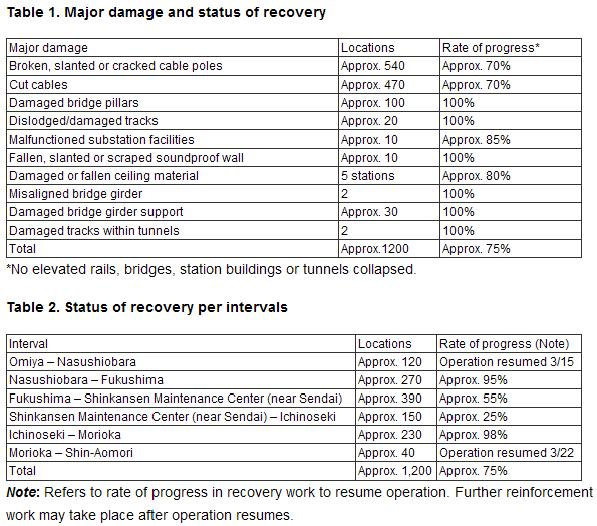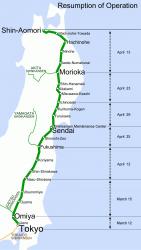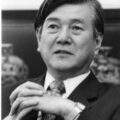RECOVERY VIA STRENGTHS OF WORKERS (PART I): RESUMING RAILWAY OPERATIONS AFTER THE EARTHQUAKE

Umehara Jun
The Tohoku Shinkansen and local lines of the quake-hit area suffered severe damage from the Great East Japan Earthquake. Yet many of the lines resumed operation between late-April and May, and passengers are returning. Behind this quick recovery were lessons learned from the past and painstaking efforts of the workers on site.
On July 9, the East Japan Railway Company (JR East) and Tohoku Shinkansen (bullet train) took another step toward complete recovery. Since the full 675 km stretch (actual distance) between Tokyo and Shin-Aomori opened on April 29, trains had to run at slow speeds between Nasushiobara and Morioka (344 km), but the subject section was reduced to the span of Fukushima to Ichinoseki (151 km). This greatly shortened the travel time from Tokyo to Shin-Aomori that had been prolonged. Hayate shinkansen trains halved their one-hour delay to 30 minutes, and Hayabusa from 55 minutes to 21. At the same time, Hayate trains departing Tokyo Station added 17 services for a total of 161, while the Hayabusa that made one run each to Shin-Aomori and Sendai resumed normal operation of two and one, respectively.
At nearly four months after the Great East Japan Earthquake, the Tohoku Shinkansen has almost fully recovered its operations.
Its full distance was opened 49 days after the quake, on April 29 – a quick recovery for the shinkansen compared to 81 days after the Great Hanshin-Awaji Earthquake in 1995 and 66 days after the Niigata-Chuetsu Earthquake.
Behind this quick recovery were three factors: lessons from the past, recovery work on site and the presence of experts.
1,200 areas damaged over a span of 645 km
The Great East Japan Earthquake struck at 2:46 p.m. on March 11. The intense tremor from the M9.0 quake centered off the coast of the Sanriku area shook the entire distance of the Tohoku Shinkansen line. The hypocenter spanned 500 km long and 200 km wide off the coast of Iwate and Ibaraki Prefecture, causing a huge tsunami that topped 10 meters in some areas.
The maximum intensity felt around the Tohoku Shinkansen rails registered 7 on the JMA scale at Kurihara City, Miyagi Prefecture, where Kurikoma-Kogen Station is located. Intensities in other areas were over-6 between Utsunomiya and Furukawa, under-6 between Ichinoseki and Shin-Hanamaki, and 4 to over-5 in other areas as well, with the tremors lasting for two to three minutes. Local railways along the coastline suffered severe damage as the tsunami washed away stations in many regions.
Yet the Tohoku Shinkansen was able to keep damage minimal since its disaster prevention system kicked in before the shaking began.
JR East, in creating its disaster prevention system, had set seismometers at 97 locations along its lines and the coast to detect preliminary earthquake tremors. Earthquakes are known to come with a forewarning preliminary tremor and then a main tremor that causes the huge shake. The seismometers were geared to ensure safety in the event of such an emergency.
When a seismometer detects a preliminary tremor and judges the main tremor to be huge, it sends an alarm to a substation to halt power supply to the rail lines. Losing power supply, the trains activate their emergency brakes and stop. This is called the Earthquake Early Detection System.
In the Great East Japan Earthquake, a seismometer set on Kinkasan, a small island off the coast of Ishinomaki City in Miyagi Prefecture, first detected the preliminary tremor. Three seconds later, emergency brakes on the Tohoku Shinkansen trains were kicking in. The huge shaking began a minute and seven seconds later. By this time, almost all trains were at or were moments from a complete stop. At the time of the earthquake, 26 trains were in operation on the Tohoku Shinkansen line, with some running at speeds of 275 km/hour. But, owing to the Earthquake Early Detection System demonstrating its capacity, not a single passenger was hurt.
On 2:50 p.m., four minutes after the quake, JR East set up action headquarters in the Shinjuku head office in Tokyo, as well as in its branches at Tokyo, Yokohama, Hachioji, Omiya, Takasaki, Mito, Chiba, Sendai, Morioka, Akita, Niigata and Nagano, and at group companies and partner businesses that perform work such as railroad maintenance. The headquarters strove to gather information on the state of damage in their responsible business domain or physical area and, sharing the information, collaborated in driving the recovery.
JR East suspended operation of all shinkansen and local lines, and its action headquarters led maintenance operations on rails, facilities and cars. The company had expected severe damage on the Tohoku Shinkansen line because of the intensity of the quake.
To add to this state, a majority of areas along the line lost power and water supply as infrastructure were damaged. Aftershocks measuring 4 in intensity continued in the Tohoku region, and recovery action began under the worst of conditions.
As expected, initial recovery and inspection work faced difficulties. Rails as well as roads around the area had incurred damage, and conditions could not be checked by maintenance vehicles. Workers split up and walked the entire 675 km of the Tohoku Shinkansen line, visually checking damage along and beneath the elevated railroad.
Through such efforts they were able to confirm most of the major damage to the line’s railroad and facilities by March 13, two days after the quake. Checks were completed on the 17th.
Damage was found at a massive 1,200 locations, as shown in Table 1 and 2, spanning a wide expanse of about 645 km between Omiya and Shin-Aomori, as listed in the Table.
Earthquake-resistant reinforcement work prevented fatal damage
The highest numbering and most widespread incidents of damage caused by the quake were in electric cable poles and the cables themselves, at about 1,100 locations. As poles broke, bent or cracked, they placed a huge load on the cables they supported; cutting or damaging them.
Yet while damage was also found in concrete structures such as supporting pillars of the elevated rails, this was all bends or cracks, and none involved complete failure (damage to a level that destroys a pillar) that would cause the elevated rails to fall or collapse.
This outcome owes to lessons from the bitter experience after the Great Hanshin-Awaji Earthquake on January 17, 1995, when an elevated section of the Sanyo Shinkansen fell and concrete dropped from a tunnel wall. JR East conducted urgent reinforcement work to improve quake resistance on shinkansen lines in the Tokyo metropolitan and Sendai areas and later in all areas following the South Sanriku Earthquake on May 26, 2003. These efforts prevented fatal damage this time around.
Third party studies also support this fact. The Concrete Commission and Structural Engineers’ Joint Mission to Survey on the Great East Japan Earthquake (led by Iwaki Ichiro, Professor of Nihon University) sent by the Japan Society of Civil Engineers clarified, “The level of structural damage was relatively small in relation to the seismic intensity.”
Inspections and recovery work on the Tohoku Shinkansen continued around the clock. The 24-hour maintenance work went smoothly compared to the normal procedures that usually take place after train services end for the day in the middle of the night until the early morning.
After the quake, many regions along the line still had no power. But since maintenance work on the Tohoku Shinkansen takes place only when power supply to the line is cut, JR East had equipped itself with numerous diesel power generators, which it used to run its inspection and recovery work.
8,500 people a day – Cooperation from other JR companies
Inspection and recovery work was, however, not always smooth. Fuel was one problem. Since the quake had damaged transportation means and traffic infrastructure to and in Tohoku and the disaster-hit areas, fuel supply stopped and the area had shortages. JR East had some reserves of its own, but they were not enough.
It was under such circumstances that JR Tokai, JR West and other businesses offered support. On the day of the earthquake, Presidents Yamada Yoshiomi of JR Tokai and Sasaki Takayuki of JR West contacted JR East President Seino Satoshi and offered cooperation, asking if there was anything the company needed. When JR East later reported it was lacking fuel, the two companies immediately promised aid. As roads to Tohoku still remained unrepaired, JR East Logistics, a subsidiary of JR East, drove in a tanker truck of fuel.
Major private railways Keikyu and Nishi-Nippon Railroad also cooperated in the recovery work. The two companies, which both run trains on same width rails as the Tohoku Shinkansen, provided rail inspection cars that measure rail status, along with other measurement equipment. These were also delivered via JR East Logistics trucks.
A JR East official recalled: “If Toyota Motor incurs damage, who would expect Nissan or Honda to offer a helping hand? But that’s exactly what happened in the railroad industry. For transporting fuel, the government and local autonomies worked things out quickly and issued us traffic passes since they considered it necessary for recovering the infrastructure. Recovery would have taken more time otherwise.”
Support came not only from railroad companies but also from other industries related to railroad.
The Japan Railway Construction, Transport and Technology Agency (JRTT; formerly the Japan Railway Construction Public Corporation), which worked on construction of the Tohoku Shinkansen, sent about 50 experts while the Railway Technical Research Institute (originally founded under Japanese National Railways [JNR]), which develops railroad technologies, sent about 12 experts to offer specific advice on recovery actions.
Obayashi, Kashima and Shimizu, contractors experienced in building the Tohoku Shinkansen lines and other railroads, also sent numerous people. Shinsei Technos, a JR Tokai affiliate, and NESCO, a subsidiary of JR West, both offered about 100 workers and equipment to work on recovering cable poles and cables that incurred the greatest damage.
Roughly 8,500 people per day from JR East, its partnering companies and other businesses and organizations resultantly worked on recovering the Tohoku Shinkansen; some of whom offered to work even though they themselves, or their family or friends, had suffered damage.
While confusion typical in fieldwork was anticipated on site, the action headquarters formed teams per area and work divisions. To speed the recovery work, three executive directors from the head office were sent to the Sendai and Morioka branches to assume field command.
The two sent to the Sendai branch were Yagishita Naomichi, co-director of the Railroad Department in charge of Facility and Electric Network Divisions, and Miyashita Naoto, co-director of the Railroad Department in charge of Safety Planning and Transport Vehicles Divisions. Hayashi Yasuo, co-director of the Railroad Department in charge of Technical Planning (General Planning Department) for the Shinanogawa Power Plant Business Improvement and Construction Divisions (both within the Railroad Department) and responsible for the JR East Research and Development Center, was sent to the Morioka branch. The three left the head office for their respective sites on the night of the earthquake, where they took command in the field of responsibility stated in their titles, assumed coordination work and communicated with the head office to push recovery work forward.
The strong ties of companies and organizations under the former employ of JNR used to be called the “JNR Family.” The way in which numerous groups this time around worked beyond corporate boundaries and business domains toward a single goal of recovering the Tohoku Shinkansen is the 21st century rendition of the JNR Family, enabled by their “rail-man spirit.”
Experts’ work sped recovery
As seen in the type of damage, post-quake recovery of the Tohoku Shinkansen was practically synonymous with concrete structural repair. Most of the railroad itself takes up a narrower swath of land than the earth-banked sections. The rails are laid over concrete planks that, in turn, are laid over concrete bridges, since concrete is more durable in snow and allows more efficient maintenance. Most of the cable poles were also made of concrete. The recovery action was supposed to require a massive amount of concrete.
Ishibashi Tadayoshi, director of the Construction Division at JR East and also director of the Structural Technology Center, which was founded to assume overall development of design and maintenance technologies for concrete structures, went to see the damaged areas of the Tohoku Shinkansen line and evaluate the possibility of repair.
“Ishibashi is a doctor of engineering and an expert on concrete,” says a JR East official. “The speed of judging the possibility of repair was a major factor in our quick recovery work.”
Much of the concrete used on the Tohoku Shinkansen was deemed safe in terms of strength and was repaired, reinforced and used as is. Work time was obviously shorter than for recovery work that involves replacing everything with new material, and it allowed precious concrete to be used in other areas of recovery work.
Through such work, confusion like that seen immediately after the quake died down after about 20 days, near the end of March, and recovery work found a certain pace. Even at this point, service resumed between Omiya and Nasushiobara on March 15 and between Morioka and Shin-Aomori on March 22.
Entering April, the entire line saw a rough schedule to recovery, and on the afternoon of the 7th, service resumed between Ichinoseki and Morioka.
“Re-damage” from aftershock did not affect recovery speed
However, around 11:32 p.m. on April 7, an earthquake measuring M7.4 struck, considered an aftershock of the March 11 quake. With Kurihara City in Miyagi Prefecture and Miyagino district in Sendai City recording an intensity of over-6 and Ichinoseki in Iwate, among other areas, registering under-6, the tremor caused another round of damage to the Tohoku Shinkansen line in some 550 locations. Prior to the aftershock, the line had only about 90 locations left to complete its recovery work, and this was now largely thrown off schedule. Locations with damage increased to about 640 and service between Ichinoseki and Shin-Aomori that had just resumed was again suspended.
Many of the 550 sites that incurred damage from the aftershock were completely new locations. Some just-repaired sites where concrete had not yet solidified and lacked sufficient strength were again damaged. “The end was in sight and then came the aftershock, which was really discouraging. Some people were in tears knowing we were back to square one,” recalled an official who served on the recovery work.
Recovery efforts resumed the following day with a revised recovery plan. Many who came to help from other organizations had already returned, but some were called back.
Even under such circumstances, the recovery did not slow. On April 12, service resumed between Nasushiobara and Fukushima, then between Morioka and Shin-Aomori the following day. Ichinoseki to Morioka resumed on the 23rd, Fukushima to the Shinkansen Maintenance Center (Sendai) on the 25th, and the remaining run from the Shinkansen Maintenance Center to Ichinoseki opened on the 29th. The Tohoku Shinkansen resumed operation over its entire line for the first time in 49 days after the earthquake.
As mentioned, trains had to reduce speed between Nasushiobara and Morioka where repaired spots and rail conditions had not yet settled, and travel time between Tokyo and Shin-Aomori was lengthened by about one hour until July 8.
But this slowed section was shortened to the Fukushima-Ichinoseki span on July 9, speeding arrival by about 30 minutes. Nightly recovery work continues to this day to return tracks and facilities within this section to a level capable of withstanding operation under maximum speed.
According to JR East, the Tohoku Shinkansen should be freed of all slowdown operations and return to its pre-quake state sometime around fall.
Recovery of the Tohoku Shinkansen, which serves as Tohoku’s grand artery, encouraged those who suffered damage from the earthquake. Its complete recovery will undoubtedly provide even greater hope.
Translated from “Shinsai karano tetsudo fukkyu monogatari,” Shukan Ekonomisto, July 192011, pp. 79-83. (Courtesy of Mainichi Shimbunsha)




